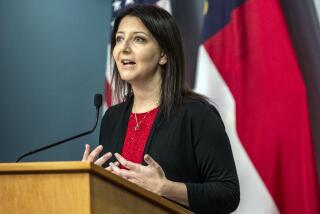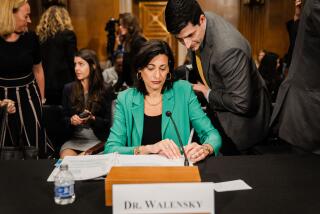First Woman Likely to Be Named to Head CDC
WASHINGTON — An infectious-disease specialist who played a leading role in the anthrax investigation is expected to be named today to head the Atlanta-based Centers for Disease Control and Prevention, according to Bush administration officials.
Dr. Julie Gerberding will become the first woman to lead the nation’s premier public health agency. Health and Human Services Secretary Tommy G. Thompson is scheduled to announce his choice--which does not require Senate confirmation--at the CDC headquarters.
Gerberding will take over an agency with more than 8,500 employees nationwide and a $6.8-billion budget. The agency has struggled with morale in the wake of criticism about its anthrax response, and Gerberding recently called the transition “tough.”
Although the CDC has many responsibilities related to homeland security, it is to remain in the Health and Human Services Department under President Bush’s proposal for a Department of Homeland Security. It has received a burst of new funds to counter the threat of bioterrorism, which hit home during the anthrax attack.
“Dr. Gerberding arrives as the director of the CDC at a time of great opportunity and substantial challenge ... , “ said Bill Roper, dean of the University of North Carolina School of Public Health and CDC director under the first President Bush. “The anthrax attacks brought very heightened visibility and new responsibility and resources. The next director must make the most of those things.”
Several top public health authorities described Gerberding’s background as uniquely suited to the new demands on a CDC director.
“If you look at threats of [the] 21st century, they are by far the threats we face from new and emerging infectious diseases, antibiotic resistance and bioterrorism, all areas Julie understands well,” said Dr. Gail Cassell of Eli Lilly and Co., who serves as bioterrorism advisor to the government and pushed for Gerberding’s appointment.
Gerberding, 46, came to the CDC in 1998 after nearly two decades at UC San Francisco, where she established herself as a leading expert in the treatment of AIDS and in medical workers exposed to HIV-positive blood. She earned a bachelor of arts degree in chemistry from Case Western Reserve University in Cleveland, graduating with honors before going on to attend the university’s medical school.
She did her internship and residency at UC San Francisco in the early 1980s and later earned a master’s degree in public health from the school. Gerberding is married and has a 21-year-old stepdaughter.
She joined the CDC as head of health care quality and led the fight against the spread of infections in hospitals. Last year she began a temporary assignment as acting deputy director of the CDC’s National Center for Infectious Diseases, a position she held when the anthrax attack began.
As a CDC insider for the last four years, Gerberding has seen firsthand the agency’s struggles with aging equipment and decrepit buildings. Thrust into the spotlight after the anthrax cases were confirmed, the CDC received an infusion of money, including about $2 billion earmarked for bioterrorism preparedness at the federal and state levels and for the acquisition of vaccines for deadly diseases, such as smallpox.
At the same time, however, many of the agency’s other programs have faced cuts.
The CDC’s top slot has been vacant since the resignation in March of Dr. Jeffrey Koplan. Koplan, who spent the majority of his career at the CDC, had defended his agency against charges it was too slow to respond to last fall’s anthrax attack, which left five dead and at least 13 others sick.
It was during the mail-launched bioterrorist attack that Gerberding rose to national prominence as a top CDC spokeswoman, earning praise from politicians and public health groups for her straightforward style and expertise.
Dr. Ivan C. A. Walks, who was head of Washington’s health department during the anthrax crisis, called Gerberding a “solid scientist.”
“She also understands the importance of the big national scientists working with the local people in order to make sure the best information is available to the public,” he said.
“She is a very sensible, extraordinarily well-informed person who doesn’t hide behind jargon or the idea that she has special knowledge about complicated matters that she really can’t quite explain,” said Dr. Julius R. Krevans, chancellor emeritus at UC San Francisco, who has known her since she was an intern.
“She’s a clinical scientist who has actually had a lot of experience dealing with patient problems,” he said. “It’s one thing to make out the guidelines and it’s another to understand that clinicians are the ones having to carry out those guidelines. She knows the difference and it will serve the public well.”
More to Read
Sign up for Essential California
The most important California stories and recommendations in your inbox every morning.
You may occasionally receive promotional content from the Los Angeles Times.











